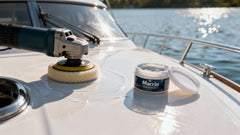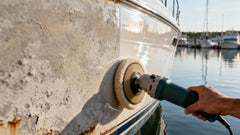How to Remove Mildew Smell for Good
Before you can get rid of that awful mildew smell for good, you have to play detective and find its source. That distinct, musty odor is actually caused by Microbial Volatile Organic Compounds (MVOCs)—basically, gases that fungi release as they grow.
This means that just spraying an air freshener is like putting a band-aid on a broken leg. The only real fix is to find the dampness that’s letting the mildew thrive in the first place.
Pinpointing the Source of Mildew Smells
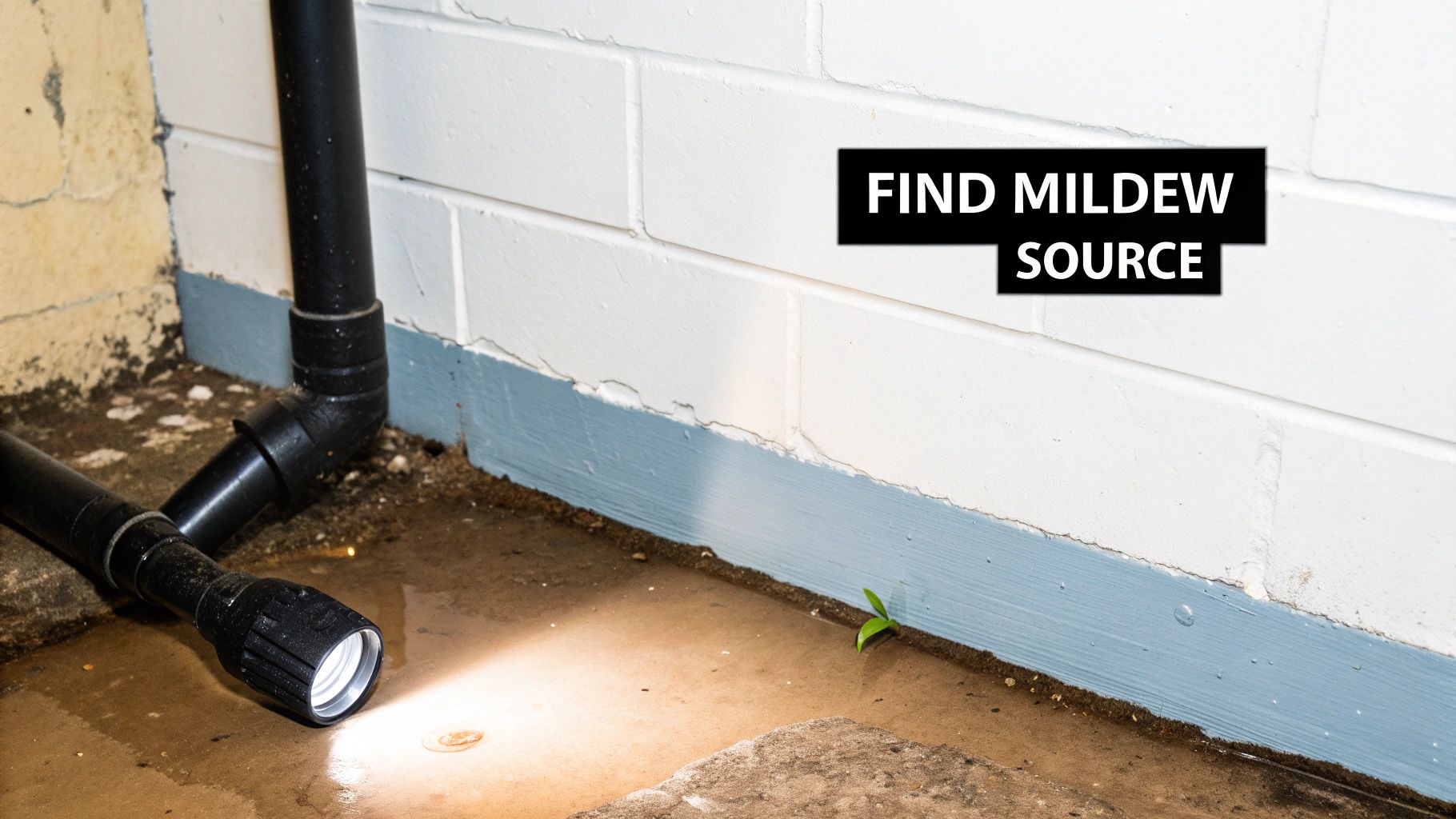
That unmistakable smell is your best clue. Think of it less as an annoyance and more as an alarm bell telling you there’s unwanted moisture somewhere nearby. Your job is to follow your nose and track down the problem area.
Mildew absolutely loves dark, damp spots with stagnant air. These are the perfect breeding grounds where moisture gets trapped, letting fungi flourish and pump those stinky MVOCs into your space.
Common Mildew Hotspots
More often than not, your search will lead you to a few usual suspects. It’s always best to start your investigation in these common problem areas:
- Bathrooms and Laundry Rooms: Poor ventilation can turn these areas into steam rooms. Always check behind toilets, under the sinks, and around the seals of your washing machine.
- Basements and Crawl Spaces: These spots are naturally cool and notorious for condensation and leaks, making them a five-star resort for mildew.
- Closets and Cabinets: The lack of airflow in these tight, enclosed spaces is a recipe for trouble, especially if you toss in damp clothes or have plumbing nearby.
- Boat Cabins and Storage: With limited ventilation and constant exposure to water, boat interiors are prime real estate for mildew. For any boat owner, knowing the ins and outs of how to clean a boat interior is an essential skill.
Why Moisture is the Main Culprit
Here’s the simple truth: without water, mildew can't survive. Period. Solving your odor problem for good means finding and fixing whatever is causing the dampness—whether it's a slow leak under a sink, condensation building up on your windows, or just high humidity in the cabin.
The core principle of mildew prevention is moisture control. If you eliminate the water source, you eliminate the mildew and its associated smell. It’s a simple but powerful truth.
People are more aware than ever of indoor air quality, which has driven huge growth in the market for odor removal solutions. The global odor removal equipment market was valued at a massive $5.76 billion in 2025 and is only expected to grow.
This reflects a wider understanding of the health risks that come with mold and mildew exposure. If you're interested in the data, you can dig into market trends for odor removal equipment growth over at archivemarketresearch.com.
Your Go-To Toolkit for Natural Odor Removal
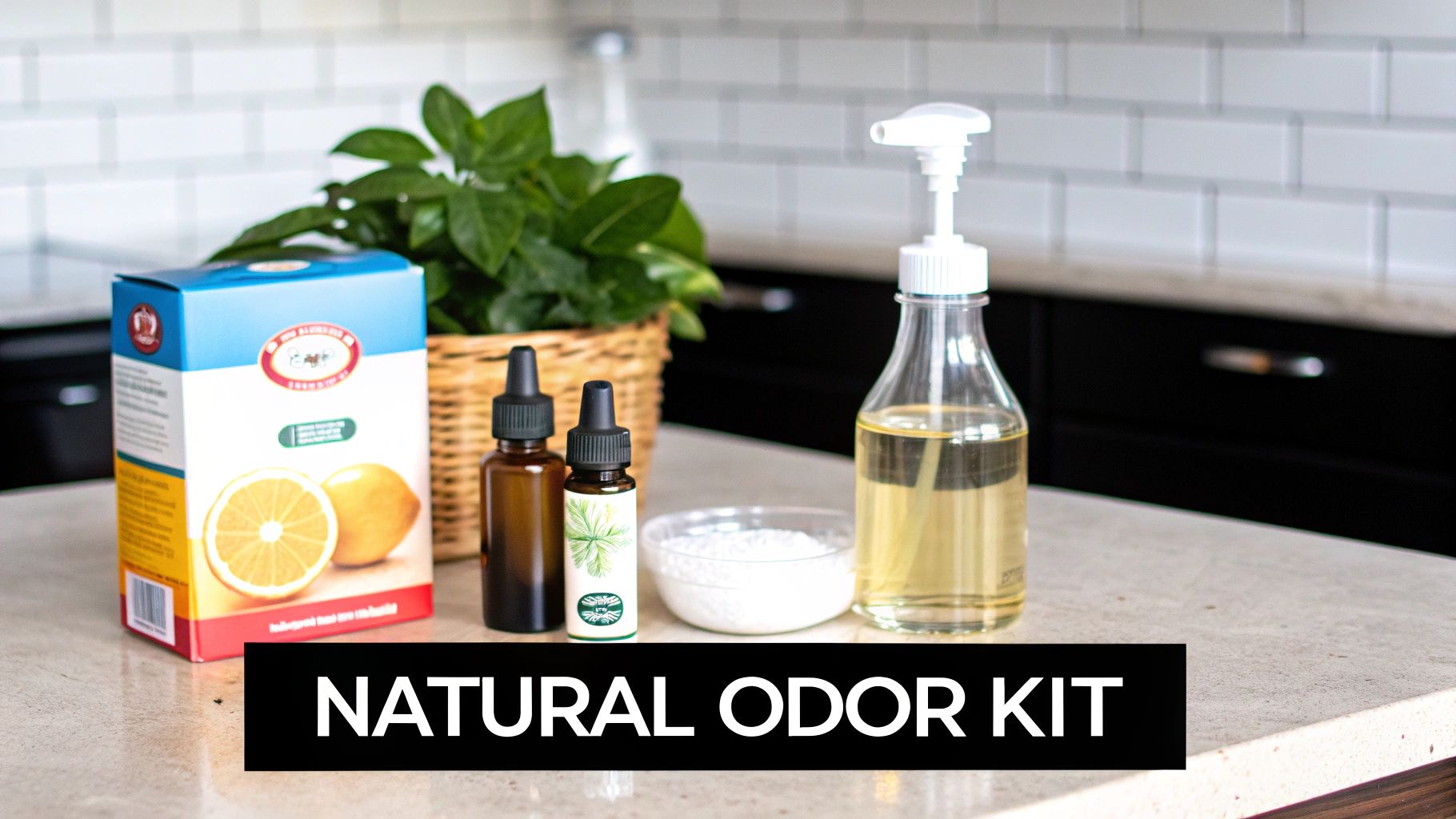
Before you grab the heavy-duty chemicals, take a look in your galley. You might be surprised to find that some of the best weapons against mildew smell are simple, cheap, and completely natural. The best part? These items don't just cover up the scent—they actually neutralize odors and kill the mildew spores causing the problem.
Putting together a natural odor-fighting kit is a breeze. Your two main players are distilled white vinegar and baking soda. These aren't just old wives' tales; they're renowned for their ability to break down the very compounds that create those musty smells.
Mastering Vinegar and Baking Soda
White vinegar is an absolute powerhouse. Its acetic acid content is strong enough to kill roughly 82% of mold species, which is pretty impressive for something you can buy at the grocery store. It's my go-to for hard, non-porous surfaces.
Just mix equal parts white vinegar and water in a spray bottle. Give countertops, vinyl seats, or the console a good spray, let it sit for an hour or so, then wipe it down. The vinegar smell disappears as it dries, and it takes that stubborn mildew odor right along with it.
Baking soda works differently—it's a fantastic odor absorber. Mildew produces acidic odors, and the alkaline nature of baking soda neutralizes them on contact. For fabrics you can’t just toss in the wash or for really tough spots, I make a thick paste with baking soda and a little water. Slather it on, let it dry completely, and then just vacuum or brush it off. You'll be amazed at how much of the smell it pulls out.
Pro Tip: Keep an open box of baking soda tucked away in a musty locker, the V-berth, or under a sink. It works just like it does in your fridge, quietly absorbing those ambient smells. Swap it out every month or two to keep it working effectively.
Beyond the Basics: Essential Oils and Sunlight
While vinegar and baking soda will handle most of the work, a couple of other natural elements can really boost your efforts.
I like to add a few drops of tea tree oil to my vinegar spray. It's a potent natural fungicide, so it adds extra mildew-killing power and leaves behind a much cleaner, fresher scent than plain vinegar.
And never, ever underestimate the power of good old-fashioned fresh air and sunlight. The sun's UV rays are fantastic at killing mildew spores and getting rid of odors naturally.
On the next dry, sunny day, haul those musty cushions, life jackets, or rugs out onto the deck. A few hours in the sun can work wonders, and it doesn't cost a thing. It’s the simplest way to tackle the smell right at the source without spraying more chemicals around your living space.
Removing Mildew Smells from Fabrics and Furniture
Fabrics are like sponges for moisture and odors, which makes them prime targets for that stubborn, musty mildew smell. We’ve all been there—a damp towel forgotten in a bag, boat cushions that never quite dried out. To get them fresh again without causing damage, you have to attack the odor at its source by killing the mildew spores trapped deep in the fibers.
Washable items like clothes, towels, or removable cushion covers are your easiest fight. But don't just toss them in for a normal wash cycle; that’s rarely enough to knock out a deeply embedded smell. You need to start with a pre-soak.
The Power of a Pre-Soak
A pre-soak is your most powerful first move. You can whip up a simple but effective solution of one part white vinegar to four parts water, or you can add a cup of borax to a bucket of water.
Completely submerge the items and let them sit for at least an hour before they even see the washing machine. This gives the solution time to break down the mildew and start neutralizing that awful smell before the main event.
After they've soaked, wash the items on the hottest setting the fabric can safely take. Hot water is incredibly effective at killing off any stubborn mildew spores that survived the soak. For a deeper dive into techniques for laundry, you can learn how to get mildew smell out of clothes.
Treating Upholstery and Non-Washable Items
So what do you do about the big stuff, like a couch, mattress, or the fixed seats on your boat? You can't exactly stuff them in the washer. For these jobs, baking soda is your best friend. Its ability to absorb and neutralize odors is seriously impressive.
Here’s the game plan for those larger surfaces:
- Make Sure It's Bone Dry: First things first, the item must be completely dry. If it's even slightly damp, set up some fans or a dehumidifier to pull out every last bit of moisture.
- Bring on the Baking Soda: Sprinkle a generous layer of baking soda over the entire surface. Don't be shy here—you want a good, even coat that covers everything.
- Let It Work Its Magic: Now, you wait. Let the baking soda sit for several hours, or even overnight for really tough odors. This gives it plenty of time to draw the musty smell out of the padding and fabric.
- Vacuum It All Up: Grab a vacuum with an upholstery attachment and go to town, making sure you get all the baking soda off the surface.
This method is a lifesaver for all kinds of furniture. If you’re dealing with this on a boat, our guide on mildew removal for boat seats has specific advice for vinyl and other common marine materials.
Key Takeaway: For non-washable furniture, getting it completely dry and then hitting it with a heavy baking soda treatment is a powerful, non-damaging way to pull mildew smells from deep within cushions and fabric.
If you’re up against an odor that just won't quit on durable upholstery, a steam cleaner can be a game-changer. The high-temperature steam penetrates deep into the fabric, killing mildew spores and sanitizing the material. Just remember to test it on a small, hidden spot first to make sure it won’t discolor or damage your fabric.
Clearing Musty Odors from Rooms and Hard Surfaces
Sometimes the mildew smell isn’t just coming from a damp towel or a forgotten life jacket—it feels like it’s baked into the very air of the cabin. When that happens, you’ve got to think bigger than just spot-cleaning. You need a room-level strategy that hits the hard surfaces and the air itself.
Your first move is to tackle the non-porous surfaces where mildew loves to cling, like vinyl, fiberglass, or sealed wood. You can start with a simple but surprisingly powerful spray made of equal parts white vinegar and water. If you’re dealing with a more stubborn situation, a few tablespoons of hydrogen peroxide in a gallon of water can give you some extra cleaning muscle.
No matter what you use, always test it on a small, out-of-the-way spot first. You want to kill mildew, not ruin your boat’s finish. Once you know it’s safe, apply the solution, let it sit for about an hour to do its work, and then wipe everything down with a clean, damp cloth.
Deodorizing the Entire Space
Okay, surfaces are clean. But what about that lingering musty funk in the air? The next step is to pull that dampness out of the atmosphere and trap those stubborn odor molecules. This is the part that really gets rid of that mildew smell for good.
Here are a few methods I’ve relied on over the years:
- Run a Dehumidifier: These things are an absolute godsend for enclosed, damp spaces like a boat cabin. A good boat dehumidifier actively yanks moisture out of the air, making the environment much less inviting for mold and mildew.
- Use Activated Charcoal: Forget baking soda. Activated charcoal is incredibly porous on a microscopic level, giving it a massive surface area that’s perfect for trapping odor molecules. Just place a few bags or open bowls of it around the room and let it do its thing.
- Get the Air Moving: Whenever you can, open up the hatches, windows, and doors. A couple of small fans can also make a huge difference in keeping the air circulating, which helps dry out any hidden damp spots and pushes the musty smell out.
While these tips work wonders on a boat, the same principles apply anywhere you're battling that old, damp smell. If the problem feels bigger than just your cabin, you might find some useful strategies to eliminate old musty smells throughout your home.
Remember, all the cleaning in the world is just a temporary fix if you don't find the source of the moisture. Hunt down that leaky portlight, condensation source, or poor ventilation that's causing the problem in the first place.
Often, the smell in the room is amplified by damp fabrics. The infographic below breaks down some of the best ways to tackle mildew odors in textiles, which can make a huge difference in the overall freshness of your cabin.
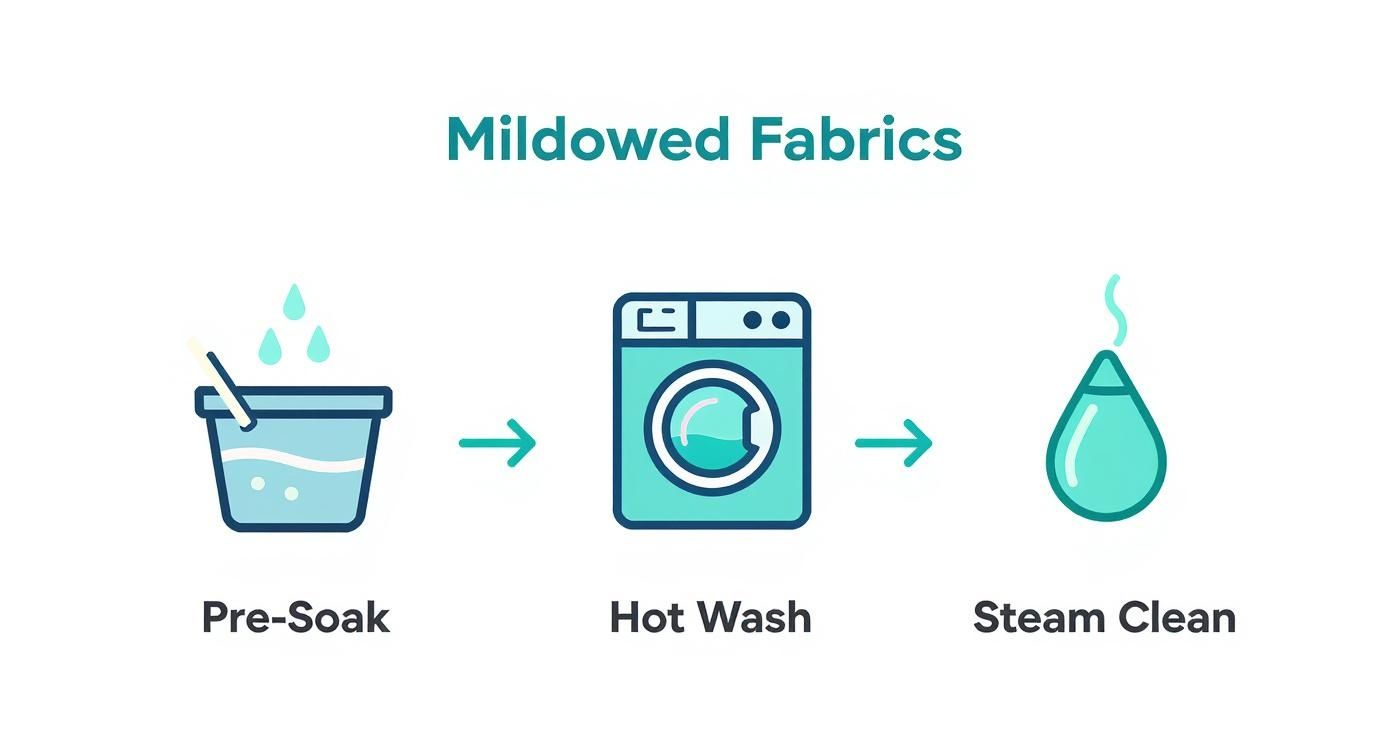
As you can see, getting mildew out of fabrics isn't always a one-and-done deal. It often takes a combination of pre-soaking, hot water washing, and sometimes even steam to fully knock out the odor.
DIY vs Commercial Mildew Odor Removers
When you’re staring down a musty surface, you have a choice: grab something from under the sink or head to the store for a specialized product. Both can work, but they have their pros and cons.
| Solution Type | Effectiveness | Best For | Safety Considerations |
|---|---|---|---|
| White Vinegar & Water | Good for light mildew and odors. | Regular maintenance on hard surfaces like fiberglass, vinyl, and sealed wood. | Non-toxic, but the smell can be strong. Always test on surfaces first. |
| Hydrogen Peroxide | More powerful than vinegar for killing mildew. | Tougher mildew spots on non-porous surfaces. It can also help lift stains. | Can act as a mild bleach; test for colorfastness on any fabric or colored surface. |
| Enzyme Cleaners | Excellent. Breaks down organic matter causing the odor. | Persistent odors, porous surfaces, and fabrics where mildew has set in deep. | Generally safe and eco-friendly, but follow product instructions carefully. |
| Chlorine Bleach-Based Products | Very effective at killing mold/mildew and removing stains. | Heavy-duty cleaning on bleach-safe surfaces like white gelcoat or tile grout. | Highly caustic. Requires good ventilation, gloves, and eye protection. Can damage fabrics and many surfaces. |
Ultimately, the best choice depends on how bad the problem is and what kind of surface you’re cleaning. For day-to-day prevention, a simple vinegar spray is great. For a serious mildew invasion, you might need to bring out the big guns with a commercial, purpose-built cleaner.
How to Prevent Mildew Smells from Coming Back
Getting rid of that musty mildew smell is a great first step, but the real win is making sure it never comes back. This is where you shift from a reactive cleaning frenzy to a proactive prevention mindset. The entire game plan boils down to one thing: moisture control. If you can keep your boat consistently dry, mildew simply doesn't stand a chance.
This all starts with building a few simple habits. Think about the spots where moisture always seems to pop up, like the galley or the head. Running the exhaust fan during and after a hot shower or while boiling water isn't just a small thing—it actively pulls humid air out of the cabin before it can condense on every surface.
Same goes for spills and condensation. Wiping up that small puddle on the cabin sole or the moisture from a portlight right away is crucial. It stops that water from seeping into wood, cushions, and other porous materials where mildew loves to set up shop.
Mastering Long-Term Moisture Control
For those areas that are just chronically damp—think lockers, bilges, or poorly ventilated cabins—you'll need to bring in the heavy hitters. Simple habits won't be enough. This is where dedicated moisture-absorbing tools become your best friend.
A quality dehumidifier is an absolute game-changer for larger problem areas. These machines actively pull water vapor right out of the air, keeping the relative humidity below that 50-60% threshold that mildew needs to thrive. Running one consistently can completely transform a musty, damp space.
For smaller, enclosed areas, specialized moisture absorbers are the perfect fit. Look for effective options that use a combination of moisture-absorbing crystals and activated charcoal.
These are ideal for tucking into hanging lockers, cabinets, or under berths where airflow is minimal. To see how these work in a marine environment, check out this combination boat dehumidifier and charcoal deodorizer built for exactly these kinds of tight spaces.
The ultimate goal is to create an environment where mildew simply cannot get the foothold it needs to survive. Consistent dryness is the most effective long-term strategy to prevent mildew smells from ever coming back.
Create an Unfriendly Environment for Mildew
Beyond just zapping humidity out of the air, think about how you store everything on board. Mildew thrives in stagnant, cluttered spaces where air can't circulate.
Here are a few simple changes that make a huge difference:
- Improve Airflow: Leave locker and cabinet doors slightly ajar when you can. Using wire shelving instead of solid panels also helps air move more freely.
- Store Items Dry: This one is non-negotiable. Never, ever put away damp towels, life jackets, or boat covers. Make sure everything is bone-dry before it gets stowed.
- Declutter Regularly: Piles of gear create dark, undisturbed pockets that are a perfect breeding ground for mildew. Keeping your boat tidy helps air circulate and lets you spot potential moisture problems before they get out of hand.
By combining these daily habits with the right tools for moisture control, you can finally stop fighting mildew smells after they appear. Instead, you'll be preventing them from ever developing in the first place. It’s all about making your boat an unwelcome place for mildew, ensuring it stays fresh and clean all season long.
Look, handling a bit of mildew yourself is one thing, but there are times when you absolutely need to call in the professionals. This isn't about giving up; it's about being smart and protecting your boat—and more importantly, your health.
Trying to tackle a serious mold problem without the right gear and know-how can backfire, spreading spores everywhere and making the problem ten times worse.
There are a few clear signs that tell you it's time to put down the spray bottle and call an expert.
Clear Signs You Need Professional Help
The most obvious tell is the sheer size of the infestation. If you've got a patch of mold or mildew that’s bigger than 10 square feet (think a 3-foot by 3-foot section), that’s your cue. That's generally the cutoff for what's considered a DIY-level job. Disturbing a colony that large can send a massive cloud of spores into the air, contaminating areas you thought were clean.
Another huge red flag is a powerful, musty odor you just can't track down. If the smell is everywhere but you can't see the source, it probably means you have a hidden mold problem.
It could be lurking behind a bulkhead, under the flooring, or deep inside your HVAC system. The pros have tools like moisture meters and thermal imaging cameras that let them find these hidden spots without ripping your boat apart.
A crucial one: if the mildew is the result of a sewage backup or contaminated floodwater, do not touch it. This is "black water," and it's teeming with dangerous bacteria and pathogens. It demands professional handling and specific disinfection protocols to make the area safe again.
Finally, think about who's on board. If anyone in your family has bad allergies, asthma, or a compromised immune system, just call a pro. Even a small amount of mold exposure can cause serious health issues for vulnerable people. It’s not worth the risk.
What to Expect from a Remediation Service
Calling a professional is a smart move, and it's becoming more common. The demand for mold remediation services is growing fast. The global market, which covers both mold and mildew odors, was valued at $1.23 billion in 2023 and is expected to climb to $1.52 billion by 2030. That growth is fueled by a greater awareness of the health risks. You can get a deeper dive into this growing industry over at grandviewresearch.com.
When you bring in a reputable service, here’s what they’ll do:
- Assess the Damage: First, they'll figure out how far the mold has spread and, crucially, what's causing the moisture that's feeding it.
- Contain the Area: They'll seal off the affected area using plastic sheeting and negative air pressure machines to stop spores from escaping during cleanup.
- Remove and Clean: Using professional-grade equipment and antimicrobial treatments, they will safely remove all the mold-infested materials.
- Verify and Dry: They'll make sure the space is bone dry and often run air quality tests to confirm that the job was done right.
Knowing when to step aside and let an expert take over is just as important as knowing how to scrub away a small spot of mildew yourself.
At Better Boat, we're all about giving you the tools for routine maintenance that stops mildew before it even gets a foothold. Check out our complete lineup of cleaning and care products to keep your vessel in top shape.



